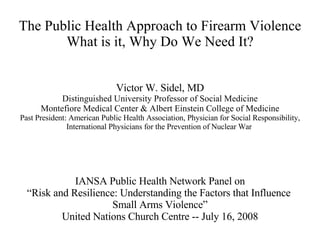The Public Health Approach to Firearm Violence "What is it, Why Do We Need It?The Public Health Approach to Firearm Violence What is it, Why Do We Need It?
- 1. The Public Health Approach to Firearm Violence What is it, Why Do We Need It? Victor W. Sidel, MD Distinguished University Professor of Social Medicine Montefiore Medical Center & Albert Einstein College of Medicine Past President: American Public Health Association, Physician for Social Responsibility, International Physicians for the Prevention of Nuclear War IANSA Public Health Network Panel on ŌĆ£ Risk and Resilience: Understanding the Factors that Influence Small Arms ViolenceŌĆØ United Nations Church Centre -- July 16, 2008
- 2. UN Program of Action on SALW The United Nations Program of Action to Prevent, Combat and Eradicate the Illicit Trade in Small Arms and Light weapons in all Aspects was initiated in 2001. It covers many of the approaches to preventing firearms violence but, despite the efforts of the World Health Organization, fails to recognize the role of the public health community in helping to solve the problem.
- 3. Approaches to Ending Firearm Violence Legal and Regulatory Correctional Educational Economic Human Rights International Treaties Public Health
- 4. In 1996, the World Health Assembly identifies violence as a leading public health problem. In 2001, the World Health Organization (WHO) prepares a document, Small Arms and Global Health , for the first UN Conference on Small Arms and Light Weapons. In its document, WHO states ŌĆ£Violence is . . . an important health problem ŌĆō and one that is largely preventable. Public health approaches have much to contribute to solving it.ŌĆØ Public Health Approach to Firearm Violence
- 5. In 2003, the World Health Organization publishes its World Report on Violence and Health in Arabic, Chinese, English, French, Italian, Russian and Spanish. The WHO Report classifies violence into three categories: Interpersonal Violence, Self-Directed Violence, and Collective Violence. Firearms play an important role in all these forms of violence and WHO advocates an integrated public health approach to prevention of all of them. Public Health Approach to Firearm Violence
- 6. ╠²
- 7. ╠²
- 8. Public Health Approach to Violence Prevention Define the Problem Identify Risk and Protection Factors Develop and Test Prevention Strategies Implement Prevention Strategies Monitor the Effectiveness of Strategies
- 9. The Epidemiologic Model Victim: Location and role Agent: Types of firearms Environment: Vulnerable factors ; protective factors; culture Involvement of health workers Public Health Approach to Violence Prevention
- 10. FIREARM INJURY CENTER Medical College of Wisconsin╠²╠²╠²
- 11. The Global Gun Epidemic The Epi Model: Victim Of the 300,000 annual gun-related deaths approximately 80, 000- 100,000 are direct conflict deaths Over 200, 000 in non-conflict contexts Disproportionate number of gun deaths occur in the Americas
- 12. The Global Gun Epidemic The Epi Mode: Agent Regardless of context, guns increase lethality Reducing inappropriate access to guns reduces the risk of injury and death Unregulated access to firearms fuels a culture of violence
- 13. The Global Gun Epidemic The Epi Mode: Environment Collective violence Interpersonal violence Self-directed violence Culture of violence
- 14. The Global Gun Epidemic Multi-layered strategy (1) Availability of current and reliable data Consideration of the entire gun supply chain, both legal and illicit Reduction of the culture of violence Post conflict demobilization, disarmament and reintegration
- 15. The Global Gun Epidemic Multi-layered strategy (2) International coordination and action Domestic violence and firearms legislation Implementation issues involving law enforcement and courts Political participation
- 16. ╠²
- 17. The Need for Global Action Coming together of different cultural, language and national traditions Coming together of different advocacy movements
- 18. ╠²
- 19. ╠²
- 20. ╠²




















